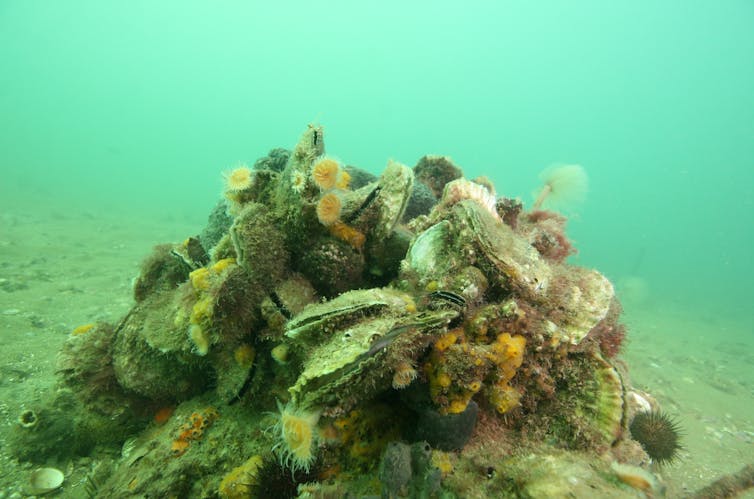
by Flinders University
Local shellfish including native razorfish and flat oysters, and feral pacific oysters, are showing strong ecosystem benefits for marine species within the Port River estuary ecosystem in Adelaide – with Flinders University researchers also discovering an exotic whelk that has found a foothold in the popular coastal area.
Environmental monitoring of the Port Adelaide marine environment, which features nearby natural assets including remnant mangrove forests and the International Bird and Dolphin Sanctuaries, has seen many changes in water quality and species composition over the years.
This led Flinders University PhD candidate Brad Martin, from the Ecosystem Resilience research group, to conduct fieldwork of the different shellfish reefs throughout the Port River earlier this year to assess the species using these poorly understood habitats.
Following the outbreak of disease in feral oysters, the South Australian Government introduced bans on collecting shellfish including oysters, mussels and razorfish in the Port River in 2018. Around the same time, local community groups also began native flat oyster restoration projects, with native shellfish reefs once common to Australia’s coastline.
As well as finding high numbers of native fishes and invertebrates, the fieldwork also found several invasive species using the feral oyster habitat, including the first detection of Hercules club whelk (Pyrazus ebeninus), which was “likely introduced through the ballast water from a shipping vessel”.
“At present these intertidal species are unlikely to have significant negative impacts on other species, but could in spread in future beyond the Port River,” he says.
“The establishment of species from the east coast like the mud whelk and Sydney cockles is also an indication of warmer conditions. Until recently, these species only appeared in the SA fossil record and had died out during one of the previous ice ages.”
The Hercules club whelk is a large marine snail that can grow up to 10cm in length and are common to estuaries on the eastern seaboard.
Stay Always Informed
Join our communities to instantly receive the most important news, reports, and analysis from the aquaculture industry.
He says the benefits of more shellfish in the area include improved water quality from their filter feeding, and providing habitat and nursery grounds for other species including recreationally important ones like whiting, bream and blue swimmer crabs.
Bradley Martin’s research work from the Port River ‘density and death: the habitat function of intertidal razorfish (Pinna biocolor) beds’ recently won the Fisheries Research Development Corporation (FRDC) Prize for Best Oral Presentation at the Australian Marine Sciences Association conference on the Gold Coast.
His supervisor Dr Ryan Baring also presented on ‘sediment stabilisation of the restored shellfish reefs,’ from research conducted on the Glenelg shellfish reef, with Associate Professor Graziela Miot da Silva, from the Beach and Dune Systems Laboratory at Flinders University
In the two years since construction, Dr Baring says oysters are now growing on the restored Glenelg shellfish reef.
“The restored Glenelg shellfish reef has lots of oysters growing that are contributing to an ecologically important nutrient sink on the seafloor, which is important for turning bad nutrients from stormwater runoff into useful nitrogen in the sea and atmosphere,” he says.
“We have also identified a reliable hydrodynamic and sediment model to performance check and fine-tune the Glenelg Shellfish Reef to improve its ability to stabilise sediments that are extremely challenging to manage along highly developed metropolitan coastlines under climate change.”
- Native oyster (Ostrea angasi) reefs were once common to Southern Australia until the 1940s when they declined due to overfishing, disease and habitat modification. In South Australia shellfish reefs occurred in coastal shorelines and estuaries, covering rocky reefs and the surface of razorfish (Pinna bicolor). Today less then <1% of these reefs remain and Ostrea angasi hold out in small numbers.
- In recent years several restoration reefs projects have been established in the Gulf St Vincent by government and community groups and The Nature Conservancy.
- Native oyster harvesting was one of the earliest fisheries industries in South Australia and was legislated with the “Oyster Bed” Act in 1853, the state’s first fisheries legislation.
- Port Adelaide was historically a hub for oyster trade with naturally occurring shellfish beds existing throughout the Port River, aquaculture/farming of native oysters from the late 1850s-1910s around Jervois Bridge and regular shipments of oysters from the Eyre and Spencer Gulf.
- The collapse of native oyster industry led to the introduction of Pacific oysters (Magallana gigas) to Australia in the 1950s with aquaculture in SA occurring from 1969 onwards. Pacific oysters have since established a feral population in the Port River, which in 2018 due to an outbreak of POMs lead to a ban on shellfish harvesting.
- Recognising the indigenous and colonial history of shellfish in Port Adelaide, Estuary Care Foundation conducted an initial subtidal restoration trial of native oysters at Jervois Bridge in 2018, with Ozfish coming on as a collaborator, leading to additional oyster baskets added in December 2022.
- In spite of poor water quality in the Inner Harbour, the area now attracts some bream, whiting, blue crabs and gobies as well as occasional snapper and salmon.
Editor at the digital magazine AquaHoy. He holds a degree in Aquaculture Biology from the National University of Santa (UNS) and a Master’s degree in Science and Innovation Management from the Polytechnic University of Valencia, with postgraduate diplomas in Business Innovation and Innovation Management. He possesses extensive experience in the aquaculture and fisheries sector, having led the Fisheries Innovation Unit of the National Program for Innovation in Fisheries and Aquaculture (PNIPA). He has served as a senior consultant in technology watch, an innovation project formulator and advisor, and a lecturer at UNS. He is a member of the Peruvian College of Biologists and was recognized by the World Aquaculture Society (WAS) in 2016 for his contribution to aquaculture.




